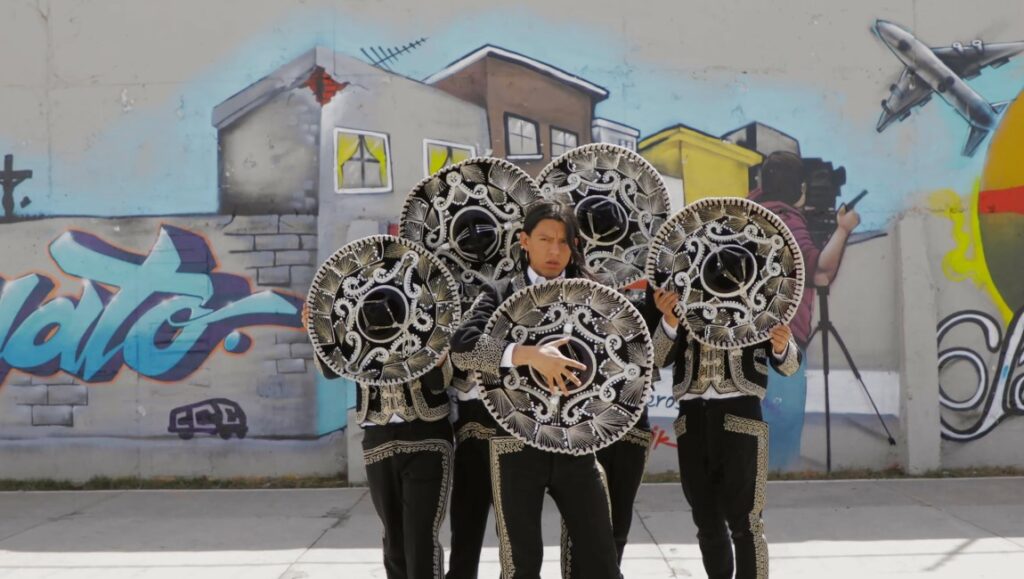When Jean-Luc Godard launched the experimental Dziga Vertov Group with Jean-Pierre Gorin in 1968, one of their primary concerns involved creating radical texts that eschewed bourgeois, capitalist norms of film production and dramaturgy — to make “political films politically,” as they put it. The problem, then, was how to get viewers interested in these works, so determined were the filmmakers to deny any of the traditional “pleasures” of cinema. Here, form and content intertwined to the detriment of the casual movie-goer, i.e., the very proletariat that Godard and Gorin wished to reach (and persuade). A similar issue arises with Amber Bemak’s new documentary 100 Ways to Cross the Border, which introduces audiences to performance artist Guillermo Gómez-Peña and his outré dance/art troupe La Pocha Nostra. A deeply political thinker, Gómez-Peña attempts to literalize the US/Mexico border and map it onto his own body. He declares borders, like nationality, as porous, fluid constructs, each patrolled and militarized by governments (and by extension fascists). For her part, Bemak takes this another step, blurring the line between director and subject, inserting herself freely into her film and even occasionally ceding control to Gómez-Peña. Call it mimetic filmmaking, a good-faith effort to expand form to the ever-changing shape of its subject. But does it go far enough?
The film begins with standard-issue footage of Gómez-Peña and his collaborators, among them Balitrónica Gómez, Michèle Ceballos Michot (“the aging ballerina”), and others. Together they imagine, rehearse, and perform what Gómez-Peña calls “political topography,” illustrated via bodies in motion and spoken-word tracts. Indeed, he calls the body an “art-fact,” a living metaphor. At a very brief 84 minutes, 100 Ways to Cross the Border could stand to be substantially longer. What we get instead is a kind of primer, a slew of ideas and sketches that evoke a potentiality more than anything else. Talking head interviews with Gómez-Peña reveal a curious, engaged, occasionally angry artist, while copious amounts of both archival and newer footage show bits and pieces of various performances. But one wishes we could see an entire uninterrupted sequence (indeed, a scene of Michot dancing around a pool that ends with her interacting directly with the camera is a playful show-stopper), even while the footage we do get is still evocative. A jumbled mix of punk rock outfits, leather gear, and Indigenous accouterment, along with props and ample nudity, quickly inform viewers that nothing is off-limits. One sequence shows Gómez-Peña pointing an assault rifle at the audience, intercut with him telling Bemak about all the different times he’s crossed the border to the US. The nicer he dressed, he tells her, the more likely he was to be “randomly selected” for a secondary inspection. But once he began dressing as a mariachi, an entertainer, the Border Patrol agents became less threatening, treating him like a harmless pal.
Gómez-Peña is determined to explore, and explode, these racist cliches and caricatures. He remarks that he’s performed at international art shows and film festivals without a single other Hispanic person in sight, and that despite winning dozens of awards and various accolades, he can barely pay a mortgage. It’s heavy stuff, which Bemak jazzes up with animated interludes, snappy montage, and humor. It’s important to convey that Gómez-Peña and his collaborators are also having fun; scenes of rehearsals and free-form improv reveal a group of artists seeking inspiration from anyone and anything. Bemak gets in on the fun herself by shedding her clothes and billing herself as the “naked director.” Her banter with Gomez-Peña is jovial but still pointed — he calls her an “East Coast, Jewish intellectual” who’s just an outsider, while she calls out his pretensions. It’s pretty obviously staged, but it brings up real concerns about cultural tourism and appropriation. Which is to say that there’s much to mull over here, perhaps even too much. 100 Ways to Cross the Border can feel disorganized at times: its chapter headings are arbitrary, and plenty of lines of inquiry get cut off before they’re explored with any real depth. Still, it’s all refreshingly playful, and an obvious labor of love for those involved. Gómez-Peña and his troupe are invigorating company, and an essential, anarchic rejoinder to our current fraught political climate. They’re out there fighting the good fight, and more power to them.
Published as part of BAMcinemaFest 2022 — Dispatch 1.


Comments are closed.